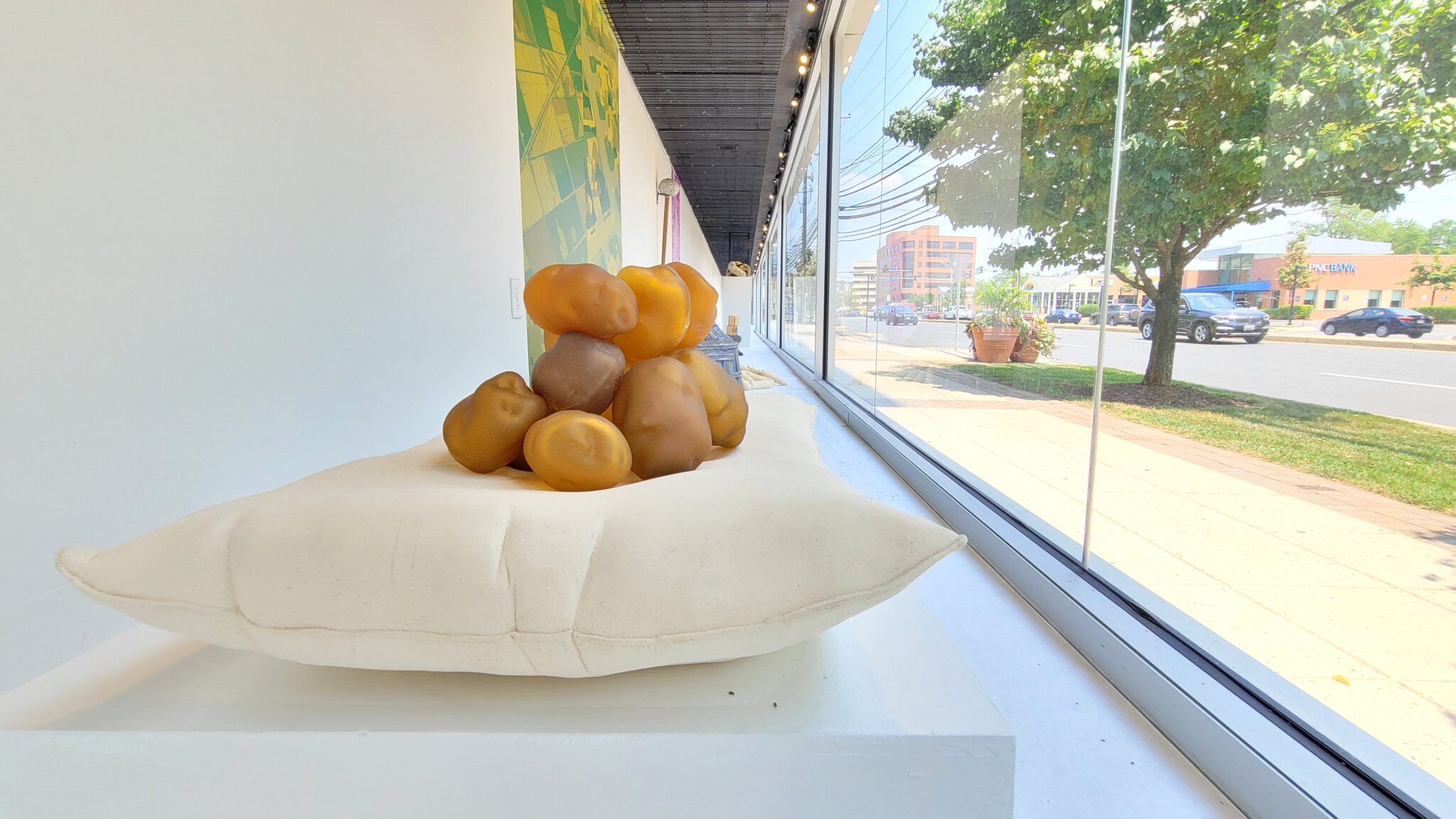
Growing Dilemma
An interview with Megan Van Wagoner
So the first question, would you please introduce yourself?
I’m Megan Van Wagoner. I’m an artist living in Tacoma Park and have been working in the DC area for the last 20 years.
The title of your work in the pod space is called Growing Dilemma. Would you talk about that, why you chose that title and the theory behind it?
Growing Dilemma is a body of work that sort of grew out of my interest in vernacular architecture and what’s happening with agricultural land.
I had started out by documenting barn structures in the Midwest, and I was printing them on clay trying to preserve some of the imagery that exists in a sort of vernacular agricultural architecture space. In doing that, you kind of get closer to what’s going on in agriculture and how land is being used, and that’s where this work really came from. It’s sort of my response or thought or meditation on how we use and value land, and the outputs of that land, so in this case, produce or agricultural products. And of course, it’s about growing, but part of it is about the growing need for food perhaps or those outputs, as well as the dilemmas that they cause.
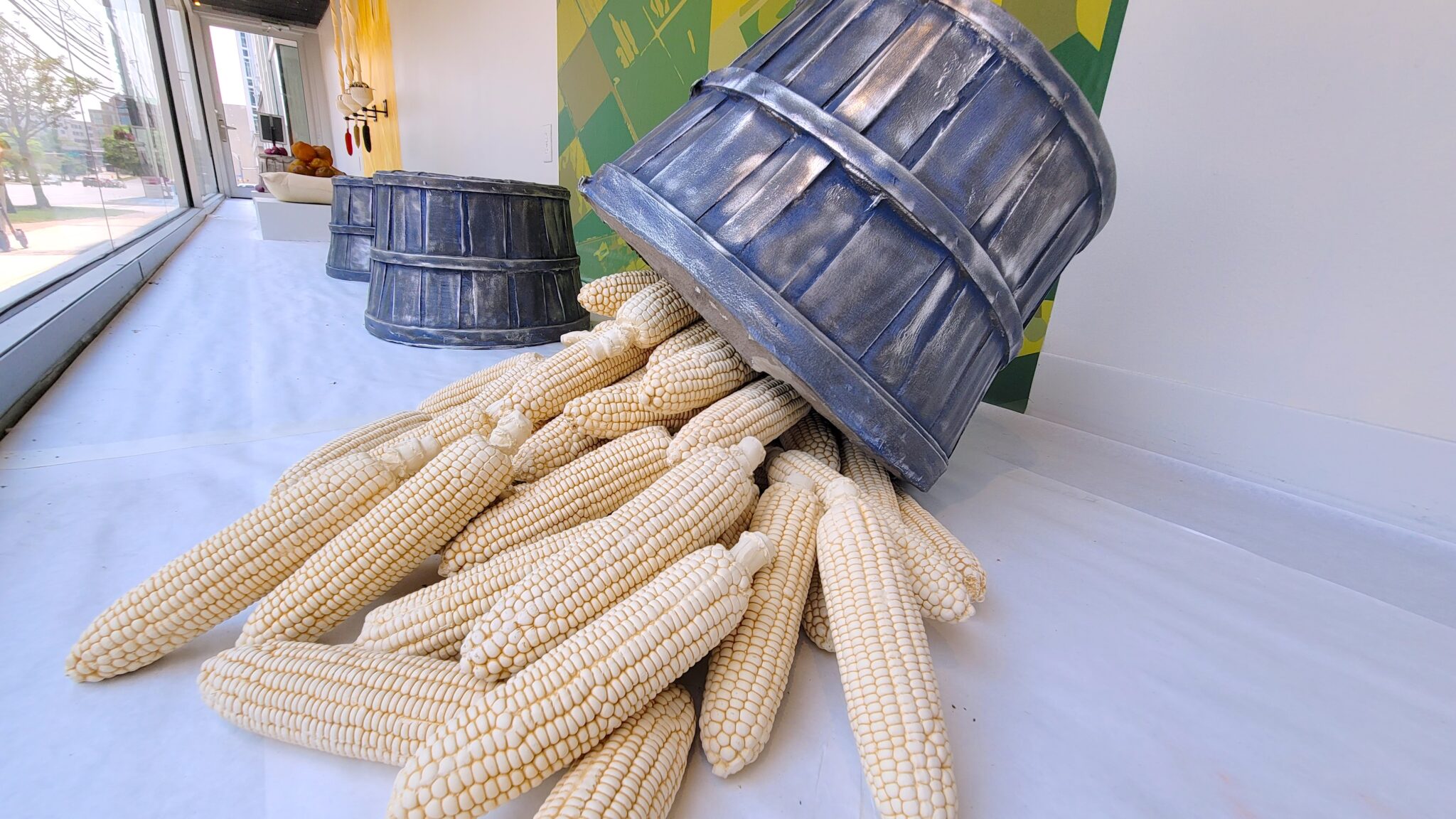
You’re a ceramicist and web designer, did these mediums come together for you in any way for this exhibition?
I studied ceramics and came to be interested in ceramics again, vernacular objects, the things that we surround ourselves with every day, so pottery was really interesting to me. Then I sort of found that I had this broader interest in communicating narrative with people or sharing my take on various subjects.
So, when I went to grad school I studied sculpture and was really digging more into the sort of fine art end of ceramics. Of course, when I got out of there, I needed a job, and I really found a parallel between what graphic designers do and what potters do. They are making things that are meant to have a function while also having aesthetic value because to do their job well they have to be aesthetically pleasing.
That was the parallel between those two but this happens in other areas of my work as well, like typography, which is a particular interest of mine in graphic design. It has come into the work through making labels because I’m really interested in objects and the narrative that objects hold. However, this was the first time I sort of made digital imagery to work with objects. The custom wallpapers that line the back of that space are to help provide context for the objects, perhaps.
I realized I give a lot of long-winded answers. But I think that like more context is probably better for understanding this level of work because it’s very layered, it’s very complex work like it’s not just one solid idea of just like ‘I’m non-binary and I want to see myself as like an icon’. I think it’s just understanding Latinx families, understanding women, understanding the queer community and being trans, and just many moving factors.
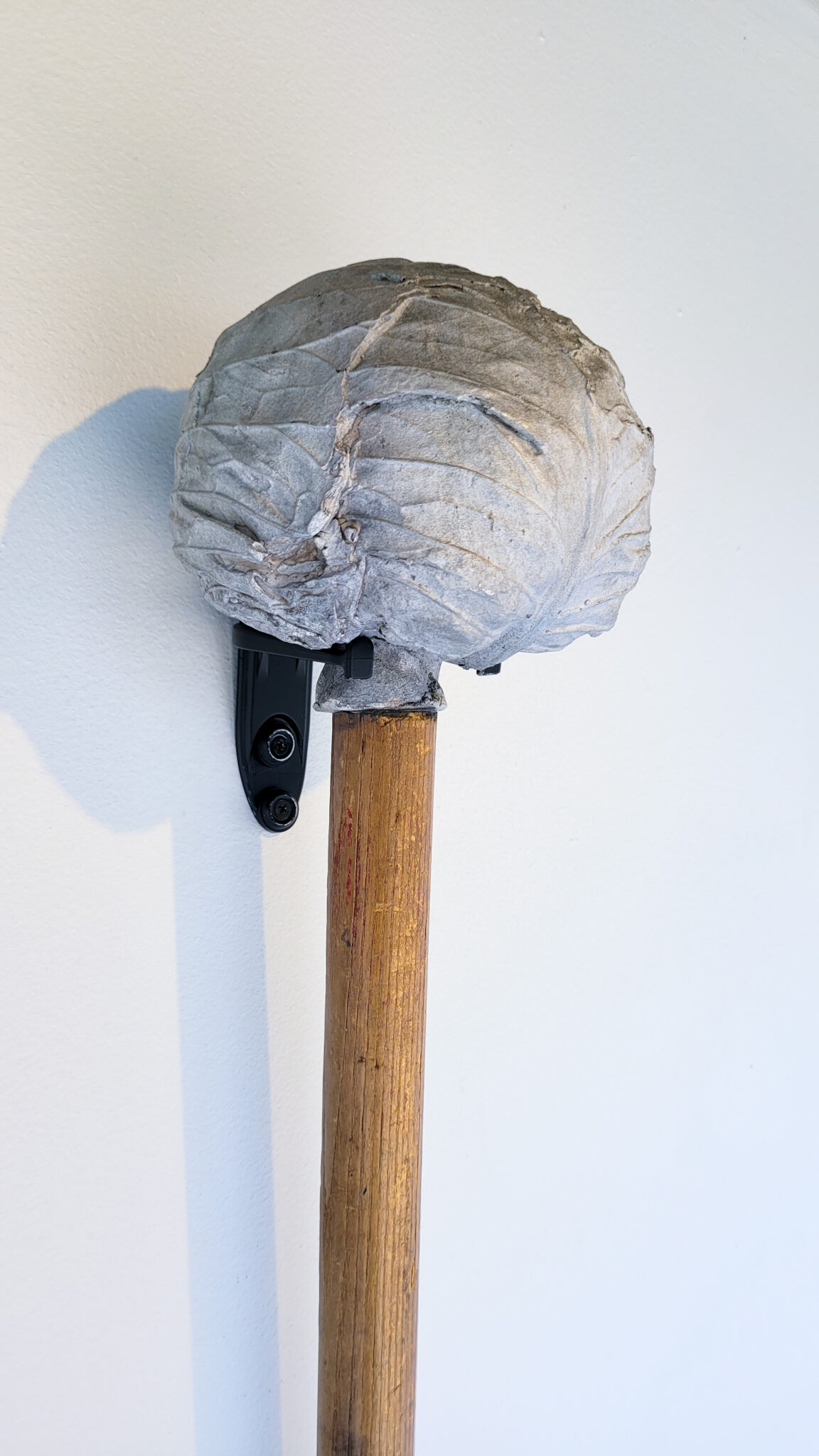
So, you might have answered this a little bit, but what is it about ceramic that makes you feel it is the best medium for investigating American agriculture?
Part of it is that the history of ceramics is one that is based in function.
One of the things I love about ceramics is that it’s a medium which has historically been both form and two-dimensional image, so there are historic examples of sculpture as well as pots which are three-dimensional forms that are covered in imagery. I love that about it.
Now for me, the physical objects that I make are much more permanent versions of everyday things. When I make a corn cob I cast it in ceramic slip and I fire it, through that process I’m taking something really impermanent and turning it into a medium that, for all intents and purposes, will be here for another 10,000 years.
Now of course I struggle with that because I’m making something that doesn’t disintegrate really, it can break of course, but as a chemical substance, it’s a very permanent material. That’s why I think taking these objects and recreating them with other materials is so important.
It’s similar to the glass potatoes and the cast ceramic objects like the corn. There’s also cast metal, so the basket trio that goes with the Three Bushel Monte piece is cast aluminum, but it’s really about taking something that is otherwise disposable or ultimately trash or will be taken back by nature and converting it into something that has a lasting life.
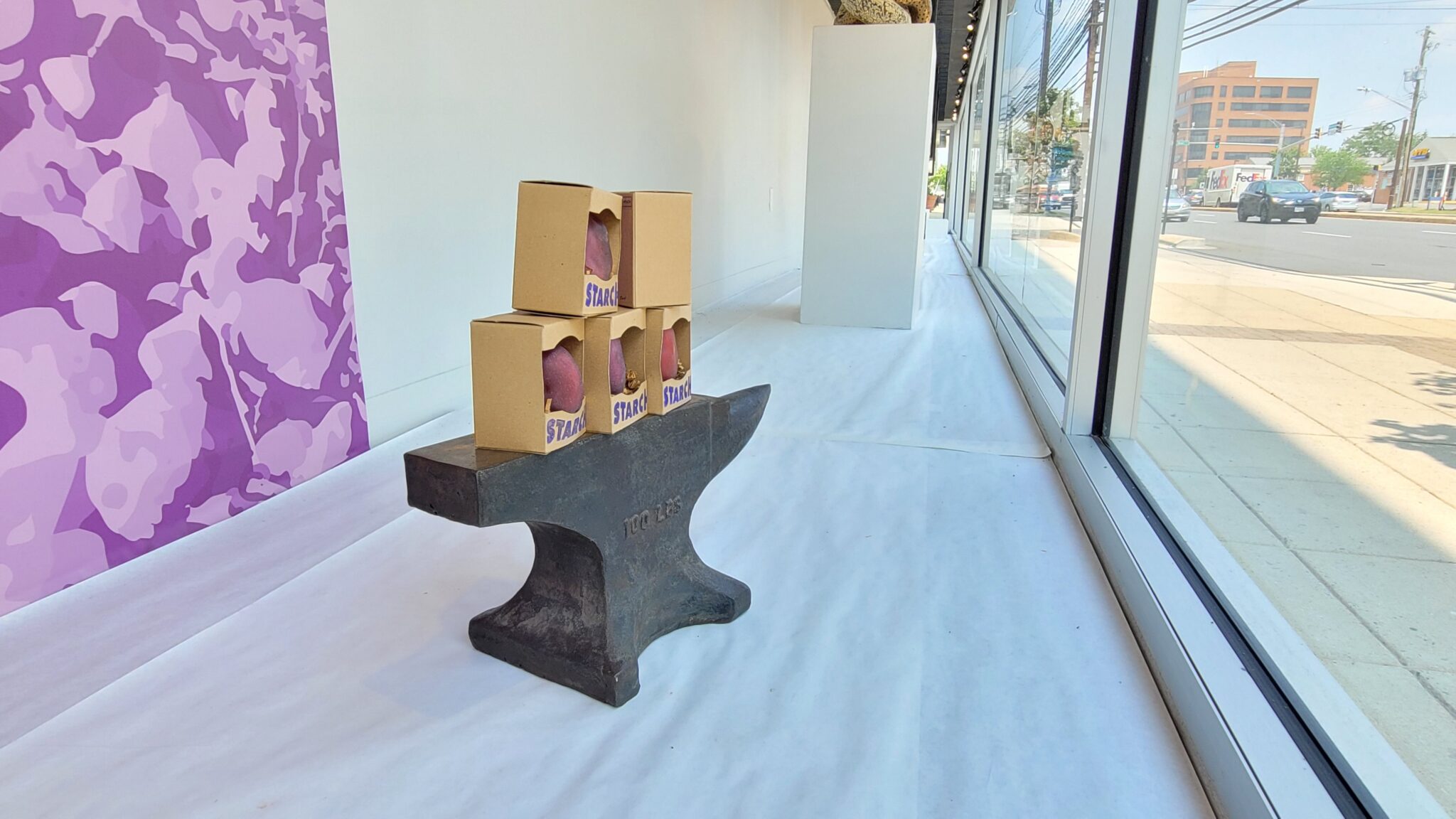
That actually goes into one of my other questions, you’re working with metal, glass, and ceramic. Some of the ceramic pieces have a matte finish, then of course there’s that piece of corn that’s dipped in gold. Would you talk a little bit about those material transitions and how this adds or takes away from the functionality of the objects?
The matte corn that’s part of the Three Bushel Monty piece is really intended to look as realistic as I can make it. I’m not exactly trying to make it look trompe-l’œil, in the sense that it’s not supposed to trick you. However, it is about real corn dumping out of that basket.
In the piece with the three corn cobs that hang from the funnels, I’m trying to address the inputs and the outputs, and the chemistry and the science that goes into agriculture these days. Each hanging ear of corn has a different surface, and each of those surfaces represents different chemical inputs.
The one with the dusty red finish to it that represents a chemical, a pesticide I think, that keeps the field clean. I’m honestly not sure they still use this but when I was a kid, this was something you saw in the cornfields all the time. I grew up in Ohio, and my family and my grandparents had some property that was in rural Ohio. We would spend a lot of time there, running around and playing in the cornfields. Along the bottom of each stalk where the roots sort of coming out of the corn, the rim had this very pink, red color from the herb – I think it’s an herbicide actually – that they put down.
The black piece of corn is representative of petroleum inputs, there’s a huge amount of petroleum that goes into the production because they’re moving and transporting things, you know halfway across the globe.
Then the last one, the gold one, is monetary inputs, the financial cost of producing it. Which of course is not, there’s not currently a balance between the inputs and the outputs, there are a lot of subsidies involved. It’s not a straight supply and demand sort of equation.
Then each one is obviously made differently, with a very unique approach. When I created the gold one I was on a sort of residency abroad in China. I had the opportunity to participate in this fuming firing basically that they can do which, for better or worse, is not allowed in the United States because it’s really chemically toxic. The black one is actually coated in rubber, and the red one is just a pigment on the surface.
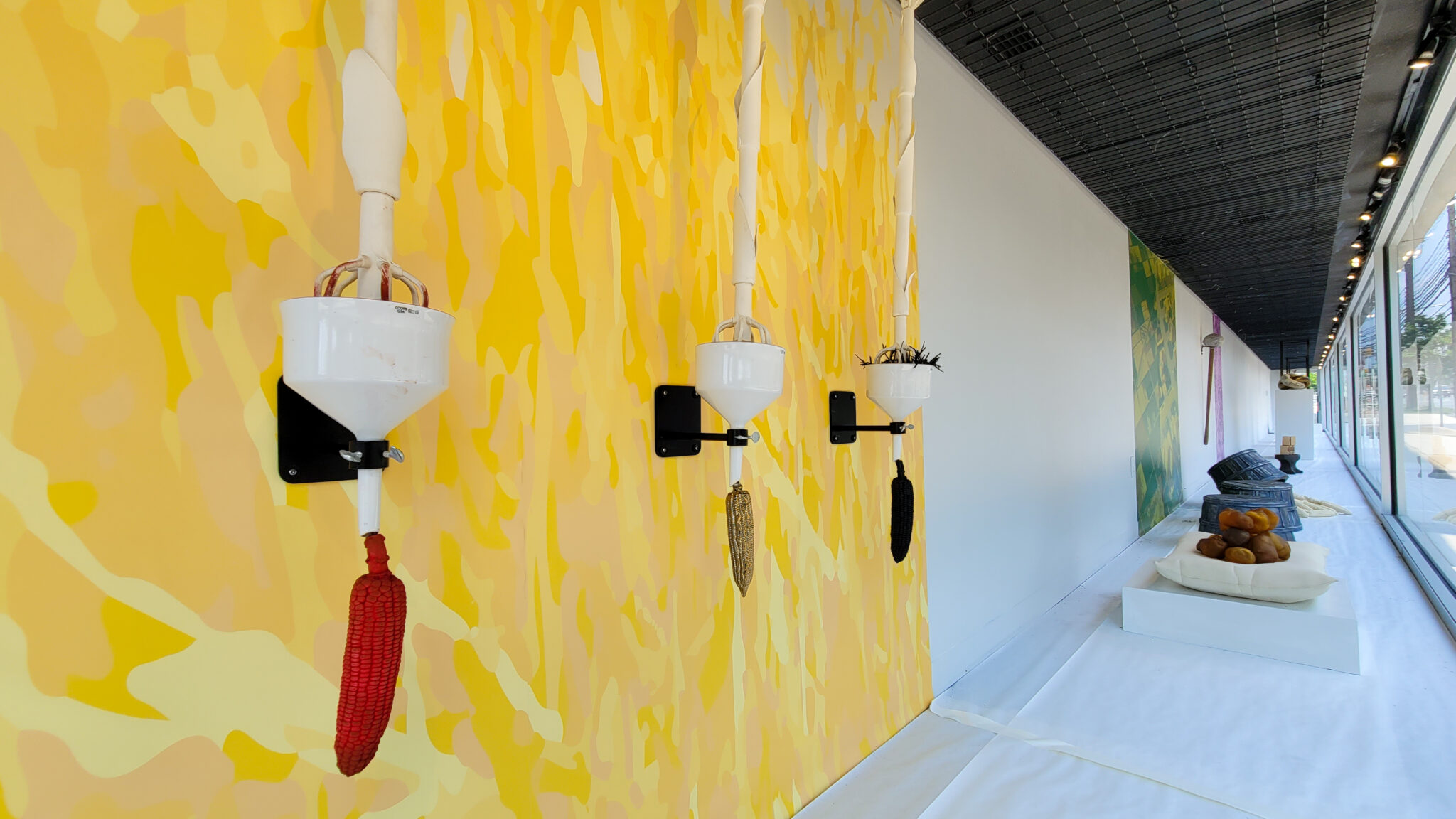
Would you talk a little bit about the silver cabbages?
The cabbages are actually cast in aluminum, I’ve done some glass cabbages as well, but the cabbage in the show is meant to be reminiscent of a tool, I tried to give it that metallic surface that a tool would have. This process also gives me the ability to get a really detailed cast straight off of an actual cabbage, so I’ve taken the mold from a real cabbage, where I can get all the undercuts and folds. It’s amazing the amount of detail you can get with that process and it seems so perfect for that particular object.
You’re working with, at least in this exhibition, corn, potatoes, and cabbage. Why did you choose those three specific foods?
The potatoes and cabbage came first. My own heritage is Irish American and I think the cabbage and potatoes to me, feel like prosperity and wealth, probably just because I grew up with that association. Then just by chance, I married into a family that has a potato farmer out in Idaho and got to spend some time at the potato farm, so I know a little bit about that process. I don’t know too much about the growth of cabbage, but you know, it was, it was just a natural sort of oil for the potato. In Ohio, by far the largest crop you see is corn, mostly grown for feed actually, but it was everywhere, like stripes rolling across fields. Corn is also interesting to me because it’s one of the crops that is subsidized and grown and stored as a commodity, which is of interest to me because as we think about how we value things, as soon as it becomes a commodity, there’s a number attached to it and that number is pretty representative of how much or little we value it as a culture. Even if I don’t think that number aligns with my take on the value of corn.
You’ve talked a lot about how your interest in corn stems from you’re upbringing in Ohio. Do you have any other specific memories or stories related to agriculture? Are you always working with food and agriculture in your practice?
I’ve always had a studio practice with two or three different things going at once. I’m interested in agriculture, although I feel like maybe I’ve reached a point where I’m starting to close the door on that.
I think the underlying theme that has tied almost all of my work over the last 20 years together is a narrative told through objects.
Growing up and going to this farm that my grandparents had, I would spend a lot of time just wandering around in the woods. On the next property over, I discovered an abandoned house full of somebody’s life, probably from 50 years before I think, but clearly, it had been empty for a long time. There was a table, some plates, a couple of chairs, and a few other remnants of somebody’s life. Discovering that house was the first time I thought about how at some point in the future, somebody is going to discover everything I’ve ever done. Then they will start to make assumptions, like when archaeologists dig something up and bring it to an anthropologist to look at it and say “well this is what that culture did”. We’re kind of making educated guesses right?
The same thing happens when we’re wandering down the street and suddenly find something that has been dropped on the sidewalk, you start to think who dropped this? what is this?
I love the idea that each object holds its own story. So, that has been pretty consistent between all the bodies of work I’ve done.
Obviously, the other thread is working in traditional ceramics, in between larger projects I end up making pots. I just have this habit of creating pots when I reach a point where I’m not quite sure what to do next. I take a break from the larger sculpture and spend a few days making bowls or cups or plates. It’s a sort of meditative studio process, where I’m able to let my mind wander.
My other most recent body of work is called Saturated with the Subconscious, which is a collaborative project with painter Eric Sandberg. A few of those pieces are up in another exhibition at VisArts as part of This Moment of Rupture. Those pieces are also about the way objects hold narratives, pillows that might harbor our deepest thoughts. After we take our heads off the pillow, what do we leave behind?

This interview was conducted by Megan Koeppel, the Exhibition Programming Coordinator.
Official Website: http://www.meganclairekoeppel.com/
